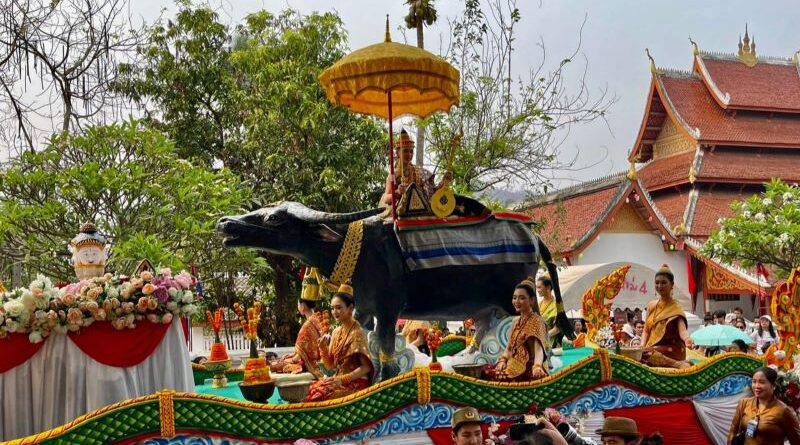The Legend of Lao New Year
Source: Vientiane Times
Pi Mai Lao (Lao New Year) is the biggest festival held in Laos and officially takes place over three days in the middle of April, but not many people know the origins of this popular festival.
The Abbot of Sikhounvieng temple (Dongmieng) in Chanthabouly district, Vientiane, Phra Archan Bounthavy Komphaphanh, shed some light on the story behind the celebrations and the customs that we preserve and hold dear today.
He recounted a long story, beginning with a rich couple who had enormous wealth but no children.
One day a drunk man came to their house and shouted “Hey, it can be good to be rich, but if you have no children your life is meaningless because when you die there is no one to inherit all the money you have saved, so it is wasted.”

The couple didn’t get angry or scold him because they knew that what he said was true.
They were worried about what the future would hold, so they made offerings of flowers, incense, candles and other items to the sun, the moon, and the deities, hoping to have a son to inherit their wealth and perpetuate their family.
One day in April, when the weather was very hot and most people spent time bathing in rivers to cool off, the rich man dressed up and led his people to perform a ritual to ask for a son from the angel that inhabited a special tree near the river.
Soon afterwards, the rich man’s wife became pregnant and gave birth to a son, who they named Thammaban Koumman.
The rich man built a small hut by the side of the river because he was happy to have a son. Every day, Thammaban Koumman liked to sit and play by the hut where many birds came to eat fruit. In addition to knowing the language of the birds, Thammaban Koumman learnt about the Hindu religion, and gained in-depth knowledge of astrology and linguistics.
Whenever someone came to him with a question or a problem, whether related to religion or daily life, he was always able to provide an answer.
Thammaban Koumman became famous and his name even became known in heaven. At that time there was a priest who was the lord of all gods and goddesses, named God Kabinlaphom. When he heard about the profound knowledge of Thammaban and the reputation he had earned, he descended to the human world to test his knowledge.
God Kabinlaphom entered into an agreement with Thammaban. “If you cannot answer my three questions, I will cut off your head as a sacrifice to the teachings of Buddha. But if you can answer all three, I will cut off my head out of respect for your knowledge,” the god told him.
The three questions were: where is the virtue of a person in the morning?; where is the virtue of a person at noon?; and where is the virtue of a person in the evening?
The agreement was that Thammaban had seven days to answer these questions, at the end of which it would be decided which of them would lose their head.
Thammaban desperately sought to find the answers, but was unable to. Nowhere could he find a reference to a person’s “siri’’. Six days went by while he searched constantly, without stopping to rest, sleep, eat or drink.
He was exhausted and reluctantly became resigned to the fact that the following day his head would be cut off. When it got dark, he clambered down from the seventh floor of the temple and walked into the woods.
Unable to move further, he lay down and closed his eyes under a big tree. Then he realised there was a lively conversation taking place between two eagles in the branches above him. The male eagle told his wife that Thammaban Koumman would certainly lose the bet because the questions were very hard and no one in this world knew the answer except for the god who had asked them, and the eagle himself.
The eagle’s wife was curious to know the answers to the questions and begged her husband to tell her. Without any hesitation, the husband gave her answers, which Thammaban heard and was able to understand because he knew the birds’ language.
The following day, Thammaban and the God Kabinlaphom met as arranged and Thammaban proudly gave the answers to the god’s questions. “The virtue of person in the morning is in the face, because when a person wakes up they wash their face. At noon, the virtue of a person lies in the chest and the body, because a person pours water on their chest and bathes. In the evening, the virtue of a person is in the feet, because the feet are washed before a person goes to bed.”
God Kabinlaphom was very surprised when Thammaban Koumman answered all the questions correctly, but he gracefully acknowledged his defeat by agreeing to cut off his head, as he had promised.
But because the god’s head was holy, if it dropped on the ground it would cause a fire and burn down the whole world. If his head rose into the air, the land would become arid and parched and people would die, and if his head fell into the ocean, the world’s waters would dry up.
So before cutting off his head, he asked his seven daughters to gather around and listen to his instructions. “My daughters,” he said, “after I cut off my head, take it and parade it around the earth’s axis 60 times, and then take it to Kay Rad Mountain. Each year, one of you must take turns to parade the head around the earth’s axis and bathe it with holy and perfumed water to show your respect, loyalty and gratitude to your father for bringing rain and prosperity to Earth.”
When the god had finished speaking, he cut off his head and the seven princesses conducted a procession of their father’s head as he had instructed, after which they returned to heaven.
This is the story of the birth of the Lao New Year celebrations and the Nang Sang Khan parade in particular. The seven daughters of God Kabinlaphom were born on each of the seven days of the festival, so each year the daughter whose birthday falls on the first day of the New Year will carry her father’s head and lead the grand parade.
Today, everyone believes that by celebrating the New Year they will get rid of their bad luck and enter a time of good luck in the coming year.
So they hold Baci ceremonies, pour water over their elders and other adults, and also pour water over Buddha images and each other, believing it will dispel misfortune, cleanse them, and allow them to start life anew.
This year’s Nang Sangkhan represents the first Miss Mahasangkan (daughter of the God Kabinlaphom), named Kimitathevi. She wears gold and crystal adornments while carrying a lute in her left hand and a sword in her right as she sits atop a life size model of a buffalo.

